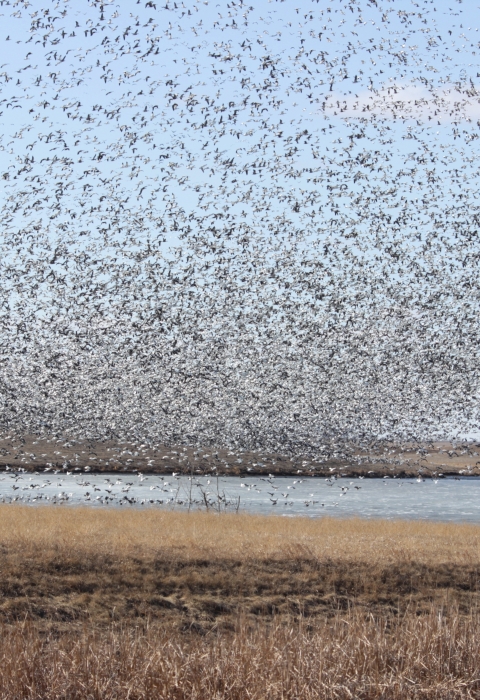Seasons of Wildlife
Spring
Spring offers the unique opportunity to see the large-scale migration of lesser snow geese. Other migratory birds such as shorebirds, wading birds and ducks can also be found using the refuge at this time. Look for bald eagle pairs nesting in trees or listen for wild turkeys gobbling to attract a mate. Spring is a great time to see and hear the diversity of species on the refuge!
Summer
Snakes and turtles are often seen crossing the auto tour. Explore the refuge during morning and evening hours for the best opportunities to view wildlife and avoid the heat of midday. Nesting songbirds are abundant during this time! Great blue herons and other wading birds can be seen in the wetland vegetation. White-tailed deer fawns and other new life are active throughout the wetlands, grasslands and woodlands.
Fall
Migratory waterfowl including a variety of duck and goose species utilize the refuge for a resting and feeding ground on their journey south for the winter. Enjoy the vibrant fall colors and practice your bird identification skills with the diverse waterbird species found in the wetlands.
Winter
Winter provides the best opportunity to see bald eagles in incredible numbers. Concentrations of ducks and geese can be found in patches of open water. Coyotes are often seen during daylight hours.
Featured Species
Lesser Snow Geese
The refuge is a mecca for large concentrations of migratory birds during the spring and fall because of the diversity and interspersion of habitats as well as the location of the refuge between two major migratory bird corridors, the Central and Mississippi flyways. By far, the most spectacular wildlife event is the migration of the snow geese in both fall and spring.
In the spring, snow geese will start back for their breeding grounds. However, the spring migration differs from the fall. The geese travel north as the spring thaw permits, along slightly different paths than during fall. More snow geese use the refuge during spring migration, sometimes millions of geese at a time. During the peak of their arrival the blue wetland is turned into a sea of white.
In the fall, snow geese begin to arrive at the refuge in mid-October with the peak in mid to late November. In the spring, snow geese will begin to arrive in mid-February with the peak in mid-March. On a typical day at the refuge, snow geese will begin to fly out at or before sunrise to feed on waste grain on private agricultural lands within the vicinity of the refuge. They will usually come and go to and from the refuge throughout the morning but by mid-day, there can be a large concentration of birds on the wetlands. In the late afternoon, birds will again fly out to neighboring fields returning again at or after sunset.
Bald Eagle
Bald eagles migrate to the refuge by late fall and early winter. As many as 300 immature and adult bald eagles and an occasional golden eagle may be seen during the migration peak, usually by the first of December. A record 662 bald eagles were counted during a 2020 survey. The first recorded successful bald eagle nest fledged three young eaglets in the summer of 1997. A few bald eagles may spend the winter and summer on the refuge. Migrating eagles leave the refuge in spring and summer returning to lakes and streams in the northern forests.
Massasauge Rattlesnake
The western Massasauga rattlesnake is a Missouri State endangered species that is dependent on the habitats on the refuge. The refuge is home to one of at least five remaining massasauga rattlesnake populations in the state. Snakes are 20-25 inches long, light grey to light brown in color with dark brown spots down the center of the back. Massasauga rattlesnakes are found in the bottomland prairie associated with wetlands. The refuge has the largest population in the state. Declining population numbers can be contributed to habitat loss and people intentionally or accidentally killing the reptile.
